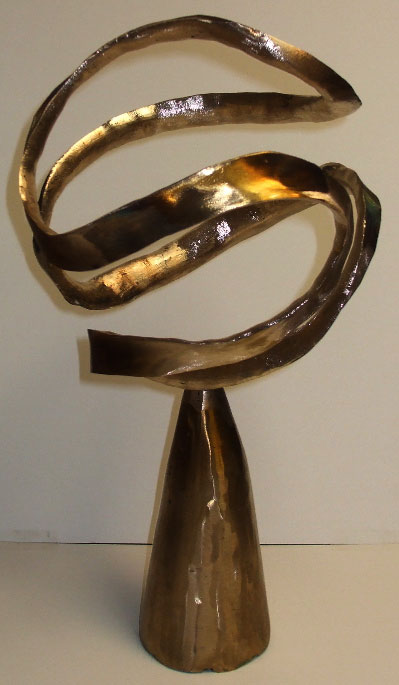
For Alex Feingold, a professor of mathematics at Binghamton University, art and math go hand in hand. His office in Whitney Hall of Old Dickinson Community feels more like an art classroom than the office of a mathematics professor, but after looking a little closer at the sculptures around the room, you’ll begin to notice patterns — and that’s exactly what he wants.
Feingold, who has been at Binghamton since 1979, makes mathematical sculptures. Though they look like works of abstract art, the sculptures are based on mathematical principles and equations.
At his first conference as a new Ph.D. in 1978, Feingold met Helaman Ferguson, who was at Brigham Young University at the time. When Feingold visited Ferguson’s home for dinner after the conference, he found several carvings in the latter’s garage. Ferguson offered to teach Feingold to make the carvings and he took him up on the offer — though the process started strangely.
“He took me outside to a fence — I thought it was just a stone fence, but it was actually a storage place,” Feingold said. “He pulled off a rock … and he said, ‘You wanna make that into something?’”
They began making the piece by drilling a hole in the center of the soft stone. Then, they used files to shape it into a torus, or a doughnut shape.
“It has a surface on it, a raised edge, and if you follow either the surface around or the edge, you’ll see that it goes around several times and then through the hole and then back to where you started,” he said.
This tactile exploration of shape was ultimately a beautiful model of the math behind the torus, too. Feingold echoes this sentiment in his written artist’s statement.
“I like best those small sculptures that can be picked up and handled, so that the tactile impressions of the hands are just as important as the image seen by the eyes,” he wrote. “Surfaces, edges, curvature and texture are the local characteristics felt, but the larger global design is what appeals to the intellect and connects to the wider world as well as to mathematical concepts.”

Though Feingold has produced many variations on the torus knot, he did not stop there. He has also produced several kinetic sound sculptures, which make a soothing noise when set in motion, and sculptures that meditate on other geometric ideas like the Mobius twist (which is a strip with a single twist that, if followed, would never cross an edge).
When Feingold was particularly interested in metal mathematical sculptures, he worked closely with Jim Stark, who formerly worked in the art department on campus as a sculpture instructor. Stark assisted Feingold in learning the processes necessary for making bronze and iron castings and allowed him to study alongside students. Now, Feingold mainly works in stone or wood when he is creating sculptures by hand. Instead, since the closure of the foundry in the sculpture studio on campus, he has also expanded his work into the world of 3-D printing, which is arguably the opposite of the carving he has previously done.
“We’re not talking about removing, we’re talking about an additive process that builds up in layers,” he said.
While working by hand forced Feingold to work mainly with approximations of mathematical equations, 3-D printing has allowed him more exactness in the forms he creates. He began by using the graphics program Rhinoceros to scale his existing works to different sizes. This program, he explained, allows the user to model the shape with the mouse or to input a formula.
Even though the sculptures Feingold creates are intimately tied to his research, he said they should be recognized as art, rather than as something with a purpose.
“I’m not making useful stuff, just surfaces,” he said.
Feingold has exhibited his sculptures across the country as far as Minneapolis and at various mathematical conferences, including the Bridges Conference. He continues to work on his sculptures when he is not teaching, and has expanded to selling his 3-D printed work online.


